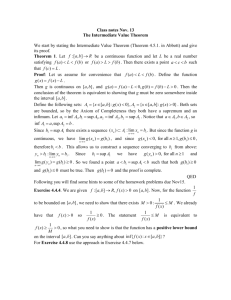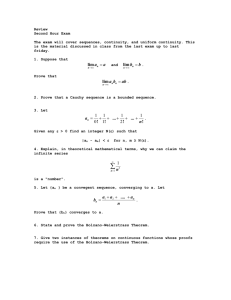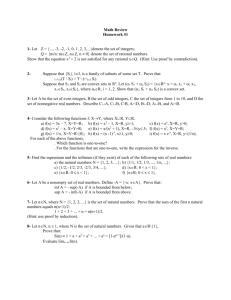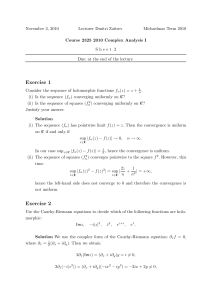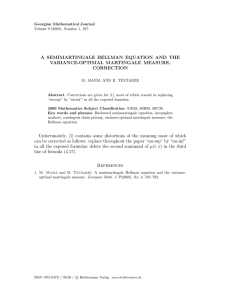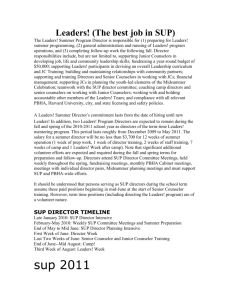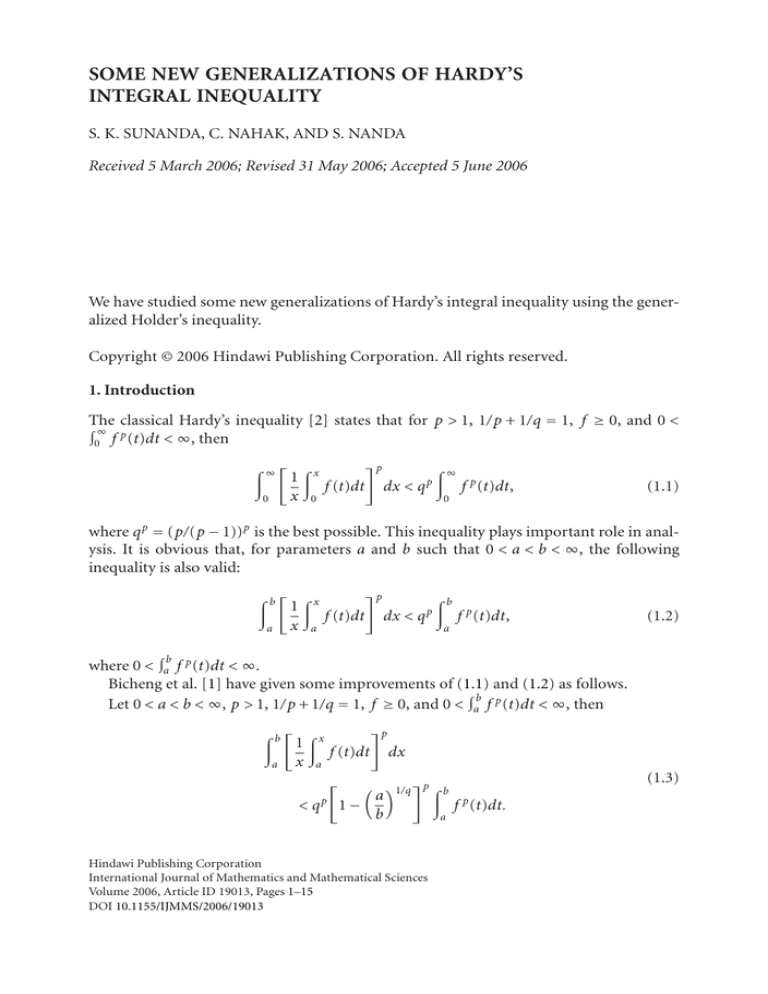
SOME NEW GENERALIZATIONS OF HARDY’S
INTEGRAL INEQUALITY
S. K. SUNANDA, C. NAHAK, AND S. NANDA
Received 5 March 2006; Revised 31 May 2006; Accepted 5 June 2006
We have studied some new generalizations of Hardy’s integral inequality using the generalized Holder’s inequality.
Copyright © 2006 Hindawi Publishing Corporation. All rights reserved.
1. Introduction
The
Hardy’s inequality [2] states that for p > 1, 1/ p + 1/q = 1, f ≥ 0, and 0 <
∞ classical
p (t)dt < ∞, then
f
0
∞ x
1
x
0
0
p
f (t)dt
dx < q
p
∞
0
f p (t)dt,
(1.1)
where q p = (p/(p − 1)) p is the best possible. This inequality plays important role in analysis. It is obvious that, for parameters a and b such that 0 < a < b < ∞, the following
inequality is also valid:
b x
a
1
x
a
p
f (t)dt
dx < q p
b
a
f p (t)dt,
(1.2)
b
where 0 < a f p (t)dt < ∞.
Bicheng et al. [1] have given some improvements of (1.1) and (1.2) as follows.
b
Let 0 < a < b < ∞, p > 1, 1/ p + 1/q = 1, f ≥ 0, and 0 < a f p (t)dt < ∞, then
b x
a
1
x
a
p
f (t)dt
< qp 1 −
dx
1/q p b
a
b
Hindawi Publishing Corporation
International Journal of Mathematics and Mathematical Sciences
Volume 2006, Article ID 19013, Pages 1–15
DOI 10.1155/IJMMS/2006/19013
a
(1.3)
f p (t)dt.
2
Some new generalizations of Hardy’s integral inequality
Let a > 0, p > 1, 1/ p + 1/q = 1, f ≥ 0, and 0 <
∞ x
1
x
a
∞
a
p
f (t)dt
a
dx < q
p
f p (t)dt < ∞, then
∞
a
1 − θ p (t) f p (t)dt,
(1.4)
p
k−1 (a/t)k/q > 0 for t > a, and θ (a) = 1/q.
where θ p (t) = 1/ p ∞
p
k=1 k (−1)
Oguntuase and Imoru [3] generalized (1.3) and (1.4) as follows.
b
Let 0 < a < b < ∞, p > 1, 1/ p + 1/q = 1 − 1/r, f ≥ 0, r > 1, and 0 < a f p (t)dt < ∞, then
b
a
1
p
x
x(1−1/r)
f (t)dt
a
< q(1−1/r)p
1
1−
r
dx
(1−1/r)p 1/q (1−1/r)p b
a
1−
b
a
Let a > 0, p > 1, 1/ p + 1/q = 1 − 1/r, f ≥ 0, r > 1, and 0 <
∞
a
1
x(1−1/r)
p
x
a
dx < q(1−1/r)p 1 −
f (t)dt
where θ p (t) = 1/(1 − 1/r)p
1/(1 − 1/r)q.
1
r
∞
a
(1−1/r)p ∞
a
(1.5)
f p (t)dt.
f p (t)dt < ∞, then
1 − θ p (t) f p (t)dt,
(1.6)
∞ (1−1/r)p k =1
(−1)k−1 (a/t)k/(1−1/r)q > 0 for t > a, and θ p (a) =
k+1
Definition 1.1. Let 1 ≤ p < ∞, then the function space L p is given by
Lp = f :
∞
0
f (x) p dx < ∞ .
(1.7)
The function space L p has been generalized to L(p) in the following manner.
Definition 1.2. Let p be a bounded measurable function, with 0 < p(x) ≤ sup p(x) = H <
∞. Define
L(p) = f :
∞
0
f (x) p(x) dx < ∞ .
(1.8)
Note that L(p) is a linear topological space paranormed by d( f ),
d( f ) =
∞
0
f (x) p(x) dx
1/M
,
(1.9)
where M = max(1,H).
In this paper, we have the generalized Holder’s inequality in L(p) space and the results
of [1, 3].
S. K. Sunanda et al. 3
2. Main results
Lemma 2.1. (a) Let the functions p and q be such that p(x)−1 + q(x)−1 = 1 for all x. Let
f ∈ L(p), g ∈ L(q). Let
A=
∞
0
f (x) p(x) dx,
B=
∞
0
g(x)q(x) dx.
(2.1)
Then for p(x) > 1, f g ∈ L1 and
∞
0
f (x)g(x)dx ≤ αβ,
(2.2)
where α = supx 1/ p(x) + supx 1/q(x), β = supx A1/ p(x) B 1/q(x) .
(b) Let 0 < p(x) < 1 and p(x)−1 + q(x)−1 = 1. If f ∈ L(p) and g ∈ L(q), then
∞
0
f (x) p(x) dx ≤ α sup p(x) + sup 1 − p(x) ,
x
(2.3)
x
where α = supx [( |g(x)|q(x) dx)1− p(x) ( | f (x)g(x)|dx) p(x) ].
Proof. To prove (a), for a,b > 0, we have
ab ≤
a p(x) bq(x)
+
p(x) q(x)
∀x.
(2.4)
Using the above inequality, we have
f (x) g(x)
A1/ p(x) B 1/q(x)
p(x)
1 f (x)
≤
p(x)
A
q(x)
1 g(x)
+
q(x)
B
.
(2.5)
Therefore,
∞ 0
f (x)g(x)
1
dx ≤
A1/ p(x) B 1/q(x)
A
∞ 0
p(x)
f (x)
p(x)
1
dx +
B
∞ q(x)
g(x)
q(x)
0
dx
(2.6)
1
1
≤ sup
+ sup
.
x p(x)
x q(x)
Also
∞
1
supx A1/ p(x) B 1/q(x)
0
f (x)g(x)dx ≤
∞ f (x)g(x)
0
A1/ p(x) B 1/q(x)
dx.
(2.7)
From (2.6) and (2.7), we get (2.2).
To prove (b), let p1 (x) = 1/ p(x), so that p1 (x) > 1 for all x. Let
−1/ p1 (x)
A(x) = g(x)
,
1/ p1 (x)
B(x) = f (x)g(x)
.
(2.8)
4
Some new generalizations of Hardy’s integral inequality
So
∞
0
f (x) p(x) dx =
∞
0
A(x)B(x)dx
≤ sup
∞
A(x)q1 (x) dx
0
x
× sup
1/q1 (x) ∞
1
1
+ sup
p1 (x)
x q1 (x)
x
0
B(x) p1 (x) dx
1/ p1 (x) (2.9)
by (2.2).
Since 1/ p1 (x) + 1/q1 (x) = 1, so 1/q1 (x) = 1 − p(x) and q1 (x) = 1/1 − p(x).
Substituting the values, we get (2.3):
∞
0
f (x) p(x) dx = sup
x
∞
0
g(x)q(x) dx
1− p(x) × sup p(x) + sup 1 − p(x)
x
∞
0
f (x)g(x)dx
p(x) = α sup p(x) + sup 1 − p(x) .
x
x
x
(2.10)
This completes the proof of the lemma.
Lemma 2.2. Let 0 < b ≤ ∞, for all x ∈ (0,b), p(x) > 1, p(x)−1 + q(x)−1 = 1, f ≥ 0, and
b
0 < 0 f p(t) (t)dt < ∞. Then the following inequality holds:
x
0
f (t)dt < α sup
inf q(x)
1/q(x)
x
sup1/q(x)2
0
x∈(0,b)
1/ p(x) x
t
1/q(t)
f
p(t)
(t)dt
,
(2.11)
where α = supx 1/ p(x) + supx 1/q(x).
Proof. For any x ∈ (0,b), by the generalized Holder’s inequality (2.2), we have
x
0
f (t)dt =
x
0
t 1/ p(t)q(t) f (t)t −1/ p(t)q(t) dt
≤ α sup
x∈(0,b)
= α sup
x
0
1/ p(x) t 1/q(t) f p(t) (t)dt
inf q(x)
1/q(x)
x∈(0,b)
0
x
sup1/q(x)2
x
(2.12)
1/ p(x) x
0
1/q(x) t −1/ p(t) dt
t
1/q(t)
f
p(t)
(t)dt
.
Strictness follows from [1, Lemma 2.1]. Thus (2.11) is valid.
−1
Lemma
x p(t) 2.3. Let a ≥ 0, for all x ∈ (a, ∞), p(x) > 1, p(x)
(t)dt < ∞. Then the following inequality is true:
a f
x
a
f (t)dt < α sup
inf q(x)
1/q(x) x∈(a,∞)
xsup1/q(x) − asup1/q(x)
−1
+ q(x)
x
a
= 1, f ≥ 0, and 0 <
1/ p(x) t 1/q(t) f p(t) (t)dt
,
(2.13)
where α = supx 1/ p(x) + supx 1/q(x).
S. K. Sunanda et al. 5
Proof. For any x ∈ (a, ∞), by the generalized Holder’s inequality (2.2), we have
x
a
f (t)dt ≤ α sup
x∈(a,∞)
a
≤ α sup
1/ p(x) x
t
1/q(t)
inf q(x)
f
p(t)
(t)dt
1/q(x) x∈(a,∞)
1/q(x) x
t
a
−1/ p(t)
xsup1/q(x) − asup1/q(x)
dt
x
a
1/ p(x) t 1/q(t) f p(t) (t)dt
.
(2.14)
Strictness follows from [1, Lemma 2.2]. This completes the proof of the lemma.
Theorem 2.4. Let 0 < a < b < ∞, for all x ∈ (a,b), p(x) > 1, p(x)−1 + q(x)−1 = 1, f ≥ 0,
b
and 0 < a f p(t) (t)dt < ∞. Then
b x
1
x
a
p(x)
M
f (t)dt
a
dx < α
inf q(t)
M
1−
sup1/q(t) M b
a
b
a
f p(t) (t)dt,
(2.15)
where M = sup p(t), α = sup{ p(t)−1 } + sup{q(t)−1 }.
Proof. Using (2.13), we obtain
b x
a
1
x
a
p(x)
f (t)dt
< αsup p(x)
×
×
x
t
a
dx
b
a
x− p(x) xsup1/q(x) − asup1/q(x)
1/q(t)
x
t
b
b
a
t
f p(t) (t)dt dx ≤ αsup p(t) inf q(t)
b b
a
2
− p(x)+sup(p(x)/q(x) )
sup(p(t)−1)
≤ αM inf q(t)
×
p(x)/q(x) x
p(x)/q(x)
sup p(t)/q(t)
sup(1/q(x)) p(x)/q(x)
a
1−
x
dx t 1/q(t) f p(t) (t)dt
sup1/q(x) p(x)/q(x)
a
1−
b
−1−1/q(x)
inf q(x)
dx t 1/q(t) f p(t) (t)dt
sup(1/q(t)) sup p(t)−1 b sup(1/q(t)) sup p(t)
a
t
≤ αM inf q(t)
1−
1−
f p(t) (t)dt
b
sup(1/q(t)) M b
M
a
≤ αM inf q(t)
1−
b
a
b
a
f p(t) (t)dt.
(2.16)
−1
−1
Theorem
∞ p(t) 2.5. Let a > 0, for all x ∈ (a, ∞), p(x) > 1, p(x) + q(x) = 1, f ≥ 0, and 0 <
(t)dt < ∞. Then
a f
∞ x
a
1
x
a
p(x)
f (t)dt
dx < αM inf q(t)
M
∞
a
1 − θM (t) f p(t) (t)dt,
(2.17)
6
Some new generalizations of Hardy’s integral inequality
k−1 (a/t)(k/inf q(t)) ], for t > a >
where θM (t) = (1/M)[ ∞
k=1 (Γ(M + 1)/Γ(k + 2)Γ(M − k))(−1)
0, M > 1, and θM (a) = sup1/q(t), M = sup p(t), and α = sup{ p(t)−1 } + sup{q(t)−1 }.
Proof. In view of inequalities (2.13) and (2.15), we find
∞ x
a
1
x
a
p(x)
f (t)dt
< αsup p(x)
×
×
x
a
dx
∞
a
x− p(x) xsup1/q(x) − asup1/q(x)
p(x)/q(x) t 1/q(t) f p(t) (t)dt dx ≤ αsup p(t) inf q(t)
∞ ∞
a
t
x−1−1/q(x) 1 −
inf q(x)
p(x)/q(x)
sup(p(t)−1)
sup(1/q(x)) p(x)/q(x)
a
b
dx t 1/q(t) f p(t) (t)dt
sup(p(t)−1)
≤ αM inf q(t)
×
∞
a
sup(1/q(x)) p(x)/q(x) ∞
t
(2.18)
a
b
1−
×
t
a
∞
a
where
f p(t) (t)dt ≤ αM inf q(t)
sup p(t)
sup(1/q(t)) sup p(t) sup(1/q(t))
1
a
1− 1−
sup p(t)
t
M
= αM inf q(t)
∞
a
a
b
d 1−
sup(1/q(t))
×
sup(1/q(x)) t
a
f p(t) (t)dt
1 − θM (t) f p(t) (t)dt,
sup(1/q(t)) M sup(1/q(t))
1
a
θM (t) = 1 −
1− 1−
M
t
t
a
t > a > 0, M > 1,
,
(2.19)
1
.
θM (a) = sup
q(t)
Since
1−
sup(1/q(t)) M
a
t
=
θM (t) =
∞
k/inf q(t)
Γ(M + 1)
a
(−1)k
Γ(k
+
1)Γ(M
−
k
+
1)
t
k =0
,
k/inf q(t)
∞
1 Γ(M + 1)
a
,
(−1)k−1
M k=1 Γ(k + 2)Γ(M − k)
t
the proof is complete.
t > a > 0, M > 1,
t > a > 0, M > 1,
(2.20)
S. K. Sunanda et al. 7
Note. When t > a > 0, by Bernoulli’s inequality (see [2, Chapter 2.4]), we obtain
sup1/q(t)
sup1/q(t) M
a
t
1−M
< 1−
a
t
,
(2.21)
sup1/q(t) sup1/q(t)
1
a
θM (t) > 1 −
1− 1−M
M
t
t
a
= 0.
Applications
Theorem 2.6. Let 0 < b ≤ ∞, for all x ∈ (0, ∞), r ≥ p(x) > 1, p(x)−1 + q(x)−1 = 1, f ≥ 0,
b
and 0 < 0 x−r+sup p(x) f p(x) (x) < ∞. Then
(i) for b ∈ (0, ∞),
b
0
x −r
x
p(x)
f (t)dt
0
dx
M
αM inf q(t)
<
inf r − p(t) q(t) + 1
b
0
sup{r − p(t)+1/q(t)} t
b
1−
t −r+sup p(t) f p(t) (t)dt,
(2.22)
(ii) for b = ∞,
∞
0
x
−r
x
0
p(x)
f (t)dt
M
αM inf q(t)
dx <
inf r − p(t) q(t) + 1
∞
0
t −r+sup p(t) f p(t) (t)dt,
(2.23)
where M = sup p(t) and α = sup{ p(t)−1 } + sup{q(t)−1 }.
Proof. For case (i), b ∈ (0, ∞), we use (2.11) to obtain
b
0
x −r
x
0
< αM
p(x)
f (t)dt
b
0
dx
x−r+sup{ p(x)/q(x)2} inf q(x)
sup{ p(t)−1}
≤ αM inf q(t)
b b
t
0
p(x)/q(x)
x
0
t 1/q(t) f p(t) (t)dt dx
x−r+sup{ p(x)−1−1/q(x)} dx t 1/q(t) f p(t) (t)dt
M
b
−r+sup{ p(t)−1/q(t)}
αM inf q(t)
≤
b
− t −r+sup{ p(t)−1/q(t)}
−r + sup p(t) − 1/q(t) 0
× t 1/q(t) f p(t) (t)dt
M
αM inf q(t)
≤
inf r − p(t) q(t) + 1
b
0
1−
sup{r − p(t)+1/q(t)} t
b
t −r+sup p(t) f p(t) (t)dt.
(2.24)
8
Some new generalizations of Hardy’s integral inequality
For case (ii), b = ∞, we use (2.11) to find
∞
0
x −r
x
p(x)
f (t)dt
0
dx
< αM inf q(t)
sup(p(t)−1)
0
sup(p(t)−1)
= αM inf q(t)
=
M
∞
∞ ∞
M
α inf q(t)
inf r − p(t) q(t) + 1
x
2
x−r+sup{ p(x)/q(x) }
t
0
∞
0
0
t 1/q(t) f p(t) (t)dt dx
(2.25)
x−r+sup{ p(x)−1−1/q(x)} dx t 1/q(t) f p(t) (t)dt
t −r+sup{ p(t)} f p(t) (t)dt.
Remark 2.7. (a) If p(x) and q(x) are constants in Lemma 2.1, then (1.6) reduces to usual
Holder’s inequality in L p space.
(b) If we take p(x) and q(x) constants in Lemmas 2.2 and 2.3 and Theorems 2.4 and
2.5, then our results reduce to the corresponding Lemmas 2.1 and 2.2 and Theorems 2.4
and 2.5 obtained in [1].
(c) When p(x) = r and q(x) is constant, inequality (2.23) reduces to (1.1).
3. Some more generalized results
In this section, we have generalized the results of [3]. We use the generalized form of
Holder’s inequality with p(x), q(x),r(x) > 1. The normalization 1/ p(x) + 1/q(x) = 1 in
Holder’s inequality is replaced by relation of the form 1/ p(x) + 1/q(x) = 1 − 1/r(x).
Lemma 3.1. Let 0 < b ≤ ∞, for all x ∈ (0,b), p(x) > 1, p(x)−1 + q(x)−1 = 1 − r(x)−1 , f ≥ 0,
b
r(x) > 1, and 0 < 0 f p(t) (t)dt < ∞. Then the following inequality holds:
x
0
f (t)dt < α sup
1−
inf
x∈(0,b)
×
x
0
t
1
q(x)
r(x)
1/ {(1−1/r(t))q(t)}
1/q(x)
2
xsup1/{(1−1/r(x))q(x) }
1/ p(x) f
p(t)
(t)dt
(3.1)
,
where α = supx 1/ p(x) + supx 1/q(x) + supx 1/r(x).
Proof. For any x ∈ (0,b), by the generalized Holder’s inequality (2.2), we have
x
0
f (t)dt =
x
0
t 1/{(1−1/r(t))p(t)q(t)} f (t)t −1/{(1−1/r(t))p(t)q(t)} dt
≤ α sup
x∈(0,b)
x
0
t 1/{(1−1/r(t))q(t)} f p(t) (t)dt
1/ p(x) x
0
t −1/{(1−1/r(t))p(t)} dt
1/q(x) S. K. Sunanda et al. 9
≤ α sup
x
0
x∈(0,b)
×
t sup{−1/{(1−1/r(t))p(t)}} dt
x
0
= α sup
t
1/ {(1−1/r(t))q(t)}
x∈(0,b)
×
1−
inf
x
0
1/q(x)
1/ p(x) f
1
q(x)
r(x)
p(t)
(t)dt
1/q(x)
xsup1/{(1−1/r(x))q(x) }
t {1/(1−1/r(t))q(t)} f p(t) (t)dt
2
1/ p(x) .
(3.2)
Strictness follows from [3, Lemma 2.1]. Thus (3.1) is valid.
−1
−1
−1
Lemma 3.2. Let a ≥ 0, for all x ∈ (a, ∞), p(x) > 1, p(x) + q(x) = 1 − r(x) , f ≥ 0,
x
r(x) > 1, and 0 < a f p(t) (t)dt < ∞. Then the following inequality holds:
x
a
f (t)dt < α sup
1−
inf
x∈(a,∞)
1
q(x)
r(x)
1/q(x)
1/q(x)
× xsup1/{(1−1/r(x))q(x)} − asup1/{(1−1/r(x))q(x)}
×
1/ p(x) x
t
a
(3.3)
1/ {(1−1/r(t))q(t)}
p(t)
f
(t)dt
,
where α = supx 1/ p(x) + supx 1/q(x) + supx 1/r(x).
Proof. For any x ∈ (a, ∞), by the generalized Holder’s inequality (2.2), we have
x
a
f (t)dt ≤ α sup
x
a
x∈(a,∞)
×
x
≤ α sup
t sup{−1/{(1−1/r(t))p(t)}} dt
a
t
1/ {(1−1/r(t))q(t)}
1−
inf
x∈(a,∞)
1/q(x)
1/ p(x) f
p(t)
(t)dt
1/q(x)
1
q(x)
r(x)
(3.4)
1/q(x)
× xsup1/{(1−1/r(x))q(x)} − asup1/{(1−1/r(x))q(x)}
1/ p(x) ×
x
a
t 1/{(1−1/r(t))q(t)} f p(t) (t)dt
.
Strictness follows from [3, Lemma 2.2]. This completes the proof of the lemma.
10
Some new generalizations of Hardy’s integral inequality
Theorem 3.3. Let 0 < a < b < ∞, for all x ∈ (a,b), p(x) > 1, p(x)−1 + q(x)−1 = 1 − r(x)−1 ,
b
f ≥ 0, r(x) > 1, and 0 < a f p(t) (t)dt < ∞. Then
b
x
1
x(1−1/r(x))
a
a
<α
M
p(x)
f (t)dt
dx
1
1−
q(t)
r(t)
inf
N 1−
sup1/{(1−1/r(t))q(t)} N b
a
b
a
f p(t) (t)dt,
(3.5)
where M = sup p(t), α = sup1/ p(t) + sup1/q(t) + sup1/r(t), and N = sup{ p(t)(1 − 1/
r(t))}.
Proof. Using (3.3), we obtain
b
a
x
1
x(1−1/r(x))
b
<
dx
1
x
a
a
p(x)
f (t)dt
αsup
(1−1/r(x))
1−
inf
1
qx
r(x)
1/q(x)
1/q(x)
× xsup1/{(1−1/r(x))q(x)} − asup1/{(1−1/r(x))q(x)}
×
x
a
t
1/ {(1−1/r(t))q(t)}
1/ p(x) p(x)
f
p(t)
(t)dt
dx
sup{ p(x)/q(x)}
1
≤ αsup p(x) inf
1−
qx
×
×
b
a
x
a
r(x)
x−(1−1/r(x))p(x) xsup1/{(1−1/r(x))q(x)} − asup1/{(1−1/r(x))q(x)}
p(x)/q(x)
t 1/q(t) f p(t) (t)dt dx
sup p(t)/q(t)
1
≤ αsup p(t) inf
1−
q(t)
×
b b
a
t
r(t)
2
x−(1−1/r(x))p(x)+sup(p(x)/(1−1/r(x))q(x) )
sup(1/(1−1/r(x))q(x)) p(x)/q(x)
a
× 1−
x
dx
sup(p(t)−1)
1
× t 1/{(1−1/r(t))q(t)} f p(t) (t)dt ≤ αM inf
1−
q(t)
r(t)
S. K. Sunanda et al.
×
b b
a
t
x
−1−1/ {(1−1/r(x))q(x)}
sup(1/(1−1/r(x))q(x)) p(x)/q(x)
a
1−
x
11
dx
× t 1/{(1−1/r(t))q(t)} f p(t) (t)dt
sup{ p(t)(1−1/r(t))}
1
≤ αM inf
1−
q(t)
r(t)
sup(1/(1−1/r(t))q(t)) sup{ p(t)(1−1/r(t))−1}
a
b
× 1−
sup(1/(1−1/r(t))q(t)) × 1−
t
b
f p(t) (t)dt
sup(1/(1−1/r(t))q(t)) N b
N 1
a
≤ αM inf
1−
q(t)
1−
f p(t) (t)dt.
r(t)
b
a
(3.6)
This completes the proof of our theorem.
Theorem 3.4. Let
∞a > 0, for all x ∈ (a, ∞), p(x) > 1, p(x)
r(x) > 1, and 0 < a f p(t) (t)dt < ∞. Then
∞
a
x(1−1/r(x))
f (t)dt
a
< αM inf
−1
+ q(x)
−1
= 1 − r(x) , f ≥ 0,
p(x)
x
1
−1
dx
1−
1
q(t)
r(t)
N ∞
a
(3.7)
1 − θN (t) f p(t) (t)dt,
k−1 (a/t)k/(1−1/r(t))inf q(t) ], for
where θN (t) = (1/N)[ ∞
k=1 (Γ(N + 1)/Γ(k + 2)Γ(N − k))(−1)
−1
−1
−1
t > a, M = sup p(t), α = sup p(t) + sup q(t) + supr(t) , and N = sup p(t)(1 − 1/r(t)).
Proof. In view of inequalities (3.3) and (3.5), we find
∞
a
x
1
x1−1/r(x)
a
p(x)
f (t)dt
< αsup p(x) inf 1 −
×
×
∞
a
∞
a
dx
1
q(x)
r(x)
sup{ p(x)/q(x)}
x−(1−1/r(x))p(x) xsup1/(1−1/r(x))q(x) − asup(1/(1−1/r(x))q(x))
t 1/(1−1/r(t))q(t) f p(t) (t)dt dx
sup{ p(t)− p(t)/r(t)−1}
1
≤ αsup p(t) inf 1 −
q(t)
r(t)
p(x)/q(x)
12
Some new generalizations of Hardy’s integral inequality
×
∞ ∞
a
t
x−(1−1/r(x))p(x)+p(x)/(1−1/r(x))q(x)
2
sup(1/(1−1/r(x))q(x)) p(x)/q(x)
a
× 1−
x
dx t 1/(1−1/r(t))q(t) f p(t) (t)dt
sup{ p(t)(1−1/r(t)}
1
≤ αM inf 1 −
q(t)
×
∞ ∞ a
r(t)
sup 1/(1−1/r(x))q(x) sup p(x)/q(x)
1−
t
a
x
sup1/(1−1/r(x))q(x) sup1/(1−1/r(t))q(t)
a
t
×d 1−
f p(t) (t)dt
x
≤ αM inf 1 −
×
∞
a
a
1
q(t)
r(t)
t
a
M
=α
sup1/(1−1/r(t))q(t) sup(1−1/r(t))p(t) 1
a
1− 1−
t
sup 1 − 1/r(t) p(t)
sup1/(1−1/r(t))q(t)
×
sup{ p(t)(1−1/r(t))}
f p(t) (t)dt
1
inf 1 −
q(t)
r(t)
N ∞
a
1 − θN (t) f p(t) (t)dt,
(3.8)
where N = sup1/(1 − 1/r(t))p(t) > 1,
θN (t) = 1 −
sup(1/(1−1/r(t))q(t)) N sup(1/(1−1/r(t))q(t))
1
a
1− 1−
N
t
t
a
,
t > a > 0,
1
q(t),
θN (a) = sup 1 − 1/r(t)
(3.9)
since
1−
sup1/(1−1/r(t))q(t) N
a
t
θN (t) =
=
∞
k/inf 1/(1−1/r(t))q(t)
Γ(N + 1)
a
(−1)k
Γ(k + 1)Γ(N − k + 1)
t
k =0
k/inf (1−1/r(t))q(t)
∞
1 Γ(N + 1)
a
,
(−1)k−1
N k=0 Γ(k + 2)Γ(N − k)
t
This completes the proof.
,
t > a > 0.
(3.10)
S. K. Sunanda et al.
13
Note. When t > a > 0, by Bernoulli’s inequality (see [2, Chapter 2.4]), we obtain
sup1/(1−1/r(t))q(t)
a
1−N
t
< 1−
sup1/(1−1/r(t))q(t) N
a
t
,
(3.11)
sup1/(1−1/r(t))q(t) sup1/(1−1/r(t))q(t)
1
a
1− 1−N
θN (t) > 1 −
N
t
t
a
= 0.
Applications
Theorem 3.5. Let 0 < b ≤ ∞, for all x ∈ (0, ∞), s ≥ N > 1, p(x)−1 + q(x)−1 = 1 − r(x)−1 ,
b
f ≥ 0, r(x) > 1, and 0 < 0 x−s+N f p(x) (x) < ∞. Then
(i) for b ∈ (0, ∞),
b
0
x −s
x
p(x)
f (t)dt
0
dx
<
N
αM inf 1 − 1/r(t) q(t)
inf 1 − 1/r(t) q(t) (s − N) + 1
b
0
{s−N+inf 1/(1−1/r(t))q(t)} 1−
t
b
(3.12)
× t −s+(1−1/r(t))p(t) f p(t) (t)dt,
(ii) for b = ∞,
∞
0
x −s
x
p(x)
f (t)dt
0
M = sup p(t),
dx < α = sup p(t)
N
αM inf 1 − 1/r(t) q(t)
inf 1 − 1/r(t) q(t) (s − N) + 1
−1
−1
+ sup q(t)
∞
0
t −s+N f p(t) (t)dt,
+ supr(t),
1
N = sup p(t) 1 −
.
r(t)
(3.13)
Proof. For case (i), b ∈ (0, ∞), we use (3.1) to obtain
b
0
x −r
x
0
p(x)
f (t)dt
dx
< αM inf 1 −
×
x
0
1
q(x)
r(x)
sup p(x)/q(x) b
0
x−s+sup{1/((1−1/r(x))q(x)2)}
t 1/(1−1/r(t))q(t) f p(t) (t)dt dx
sup{ p(t)/q(t)}
1
≤ αM inf 1 −
q(t)
r(t)
×
b b
0
t
x−s+sup{1/(1−1/r(x))p(x)−1/(1−1/r(x))q(x)−1} dx t 1/(1−1/r(t))q(t) f p(t) (t)dt
14
Some new generalizations of Hardy’s integral inequality
sup(1−1/r(t))p(t)−1
αM inf 1 − 1/r(t) q(t)
≤
−s + sup 1 − 1/r(t) p(t) − 1/ 1 − 1/r(t) q(t)
×
b
b−s+sup{(1−1/r(t))p(t)−1/(1−1/r(t))q(t)} − t −s+sup{(1−1/r(t))p(t)−1/(1−1/r(t))q(t)}
0
×t
1/(1−1/r(t))q(t)
f p(t) (t)dt
N
αM inf 1 − 1/r(t) q(t)
≤
inf 1 − 1/r(t) q(t) (s − N) + 1
×t
−s+sup(1−1/r(t))p(t)
f
p(t)
b
0
s−N+inf {(1−1/r(t))q(t)} 1−
t
b
(t)dt.
(3.14)
For case (ii), b = ∞, we use (3.1) to find
∞
0
x −s
x
p(x)
f (t)dt
0
dx
< αM inf 1 −
×
x
0
1
q(x)
r(x)
sup p(x)/q(x) ∞
0
2
x−s+sup{1/(1−1/r(x))q(x) }
t 1/(1−1/r(t))q(t) f p(t) (t)dt dx
sup p(t)/q(t)
1
= αM inf 1 −
q(t)
×
∞ ∞
×t
t
0
x−s+sup{1/(1−1/r(x))p(x)−1/(1−1/r(x))q(x)−1} dx
1/(1−1/r(t))q(t)
=
(3.15)
r(t)
f p(t) (t)dt
N
αM inf 1 − 1/r(t) q(t)
inf 1 − 1/r(t) q(t) (s − N) + 1
∞
0
t −s+N f p(t) (t)dt.
Remark 3.6. (a) If p(x), q(x), and r(x) are constants in Lemmas 3.1 and 3.2 and Theorems 3.3 and 3.4, then our results reduce to the corresponding Lemmas 2.1 and 2.2 and
Theorems 2.4 and 2.5 obtained in [3].
(b) If we take r(x) → ∞ in Theorems 3.3 and 3.4, then it reduces to corresponding
Theorems 2.4 and 2.5.
(c) In the limits a → 0, b → ∞, r(x) → ∞, p(x) and q(x) constants, (3.5) reduces to
(1.1). Hence (3.5) is the generalization of (1.1).
Acknowledgments
The authors wish to thank the referees and Professor Lokenath Debnath, IJMMS Managing Editor for their valuable suggestions which improved the presentation of the paper.
S. K. Sunanda et al.
15
References
[1] Y. Bicheng, Z. Zhuohua, and L. Debnath, On new generalizations of Hardy’s integral inequality,
Journal of Mathematical Analysis and Applications 217 (1998), no. 1, 321–327.
[2] G. H. Hardy, J. E. Littlewood, and G. Pólya, Inequalities, Cambridge University Press, Massachusetts, 1952.
[3] J. A. Oguntuase and C. O. Imoru, New generalizations of Hardy’s integral inequality, Journal of
Mathematical Analysis and Applications 241 (2000), no. 1, 73–82.
S. K. Sunanda: Department of Mathematics, Indian Institute of Technology, Kharagpur,
Kharagpur 721 302, India
E-mail address: sunanda@maths.iitkgp.ernet.in
C. Nahak: Department of Mathematics, Indian Institute of Technology, Kharagpur,
Kharagpur 721 302, India
E-mail address: cnahak@maths.iitkgp.ernet.in
S. Nanda: Department of Mathematics, Indian Institute of Technology, Kharagpur,
Kharagpur 721 302, India
Current address: North Orissa University, Baripada, Distt. Mayurbhanj, Orissa 757003, India
E-mail address: snanda@maths.iitkgp.ernet.in

